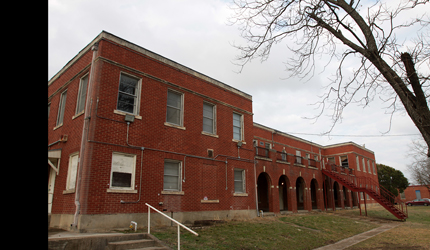
An old dorm building from the Waco State Home, which was closed in 1979, now houses the Waco Center for Youth.
Author delves into stories, will speak today
By Wakeelah Crutison and James Byers
Copy Editor and News Editor
In the new book “We Were Not Orphans: Stories from the Waco State Home,” author Sherry Matthews delves into the history of the children’s home and exposes a fettered past of physical, sexual and emotional abuse.
Matthews and alumni from the home will speak about her book at 3 p.m. today in Bennett Auditorium in Draper Academic Building. She will sign books after the event at the Texas Collection in Carroll Library and will also hold a book signing at 7:30 p.m. today at the Barnes and Nobles Booksellers located on West Waco Drive.
Matthews attended Baylor and majored in journalism but left the program to marry a Baylor faculty member. She graduated with a B.A. in journalism from Memphis University. Matthews said she’s glad to be able to come back to Baylor to share her experiences with students.
“It’s a rare collection of stories,” Matthews said. “As far as I know, no one has collected this many oral stories of abuse in a children’s institution. It’s rare to have more than 60 stories and for people to hear first-person accounts.”
The book, published by University of Texas Press, contains more than 50 tales of life at the Waco State Home spanning from the time the home opened its door in 1923 to children in need to the day the home closed in 1979.
“[The book] gives voice to a community of people who shared a circumstance in a particular time over an entire history,” William Bishel, acquisition editor at the University of Texas Press, said. “They formed a community and it’s important for every community to have a voice outlet.”

Matthews found her literary voice at a young age when her brother, Donald, introduced her to the world of writing by giving her a typewriter. She declared herself the family’s writer while her brother was the artist in the family.
After her family suffered a series of tragedies, she was sent to live with her great-aunt and uncle in East Texas when she was 3 and her brothers went to the Waco State Home.
Her brothers never talked about their experiences living there, but her brother Bing introduced her to alumni of the home at a 2004 reunion. The alumni were more forthcoming, Matthews said.
“As soon as they realized my brothers went there, they were willing to talk to me,” Matthews said. “A lot remembered Donald and his paintings and the things he did artistically at the home. They were eager to talk to me about him and their experiences. My brothers never talked about their time at the home, so I never knew what to expect.”
Matthews said she was surprised by how many people were interested in sharing their stories with her when they found out about her venture to write a book on the Waco State Home. She said most of the initial stories were positive.
“The alumni told fabulous stories. They talked about the fun they had and the friendships they made, and the families they built,” Matthews said.
It wasn’t until later that she discovered the dark underlining of the home intended to be a safe haven for children.
Matthews, realizing the magnitude of the project, enlisted the help of several people to help with research and conducting interviews. One of her interviewers shocked her with the news of a former inhabitant who reported subjection to physical abuse.
“I was horrified and it made me sick,” Matthews said. “I realized it was why my brothers never talked about it. I did some research and found there were secret hearings and cover-ups. I knew many people were expecting a happy book with positive stories. But the stories I heard were chilling.”
The book features a testimony from Mary “Liz” Westbrook Benton, who attended the Waco State Home from 1966 to 1967.
“I think everyone who was out there was harmed in one way or another,” Benton said in the book. “There is trauma when you have to leave your family and go in a place like that, and then there is more trauma once you are in there, cut off from your family. Then comes the abuse and the aftermath of that abuse for the rest of your life.”
It also features an account of the fear some children felt while staying at the institution.
“Our minds were molded to think as the dorm matrons wanted us to think, to remind us that even the simplest of acts could result in a beating,” Linda Prather D’Agostino, resident of the home from 1965 to 1974, said in the book.
Matthews said one dorm mother reported a conversation with a dean of the home who ordered her to beat a child every day in front of the other children to keep them in line. The dorm mother refused and was fired. Having recorded the conversation, the woman filed for wrongful termination, and in turn, the dean was fired from his position.
Matthews said the stories show how the state could allow the abuse to happen. She said some officials even referred to the children in the Waco State Home as inmates.
“They hadn’t committed any crimes,” Matthews said. “These were just children whose families could no longer take care of them. It’s an important piece of history and shows how we treat children, the most vulnerable children.”
Not all the stories in the book are bad. Some former inhabitants recall fond memories and depict the home as a shelter where they received compassion, food, a sense of family and a haven that kept them off the street.
Fernando “Freddy” Reyes lived at the Waco State Home from 1964 to 1972.
“My view is that everything went well for me at the Home,” Reyes said in the book. “We were pretty well sheltered from the troubles outside.”
Matthews said the large difference between the children’s experiences likely stemmed from the luck of the draw. She said other factors, such as a child’s personality, may have also played a role in how much abuse a child was subjected to at the home.
“If they entered very young, they learned the rules at an early age and knew how to stay out of trouble,” Matthews said. “Kids who came from a loving environment, who loved their parents and whose parents loved them, didn’t like being separated.”
Matthews said older kids with established ideals and behaviors had a harder time adjusting.
“My brother [Donald] hated it,” Matthews said. “He ran away, but they didn’t beat him because he made money for the home by painting murals and pictures around town. He was beneficial to the image of the home, so they gave him special treatment.”
While staffers abused some children, not all of the Waco State Home staff resorted to such tactics.
“Some years were worse than others,” Matthews said. “It depended on whoever was in charge.”
Matthews said the home was run with compassion and care when superintendent Rebecca Canning, now Rebecca Brumley, took over in 1974.
Brumley’s reforms put a stop to the abuse and led to an eventual closing of the Waco State Home in 1979. The building now houses the Waco Center for Youth.
Matthews said she has received mixed reviews of the book from the home’s alumni. The reactions to the book were just as varied as the tales inside it.
“There were some people who were not abused who thought if the book came out, people would assume they were treated that way. There were also some who were abused but didn’t want to remember what happened to them,” Matthews said. “It’s very interesting; some confront it and others are very disturbed by it. Then there are many who say the truth should be known.”
Matthews said it was an incredible experience to meet the alumni and listen to their stories.
“The experience has given me insight into what my brothers went through,” Matthews said. “It was emotionally wrenching, and it made me more determined to always speak up for injustice. Silence is the real problem. There will always be evil in the world and people who do bad things. But the real evil is when there is abuse and people know and don’t speak up.”






